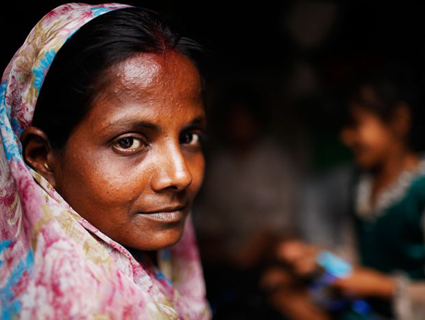
Photographs by Michael Rubenstein
IT’S MIDNIGHT on the streets of Calcutta. Old women cook over open fires on the sidewalks. Men wait in line at municipal hand pumps to lather skin, hair, and lungis (skirts), bathing without undressing. Girls sit in the open beds of bicycle-powered trucks, braiding their hair. The monsoon’s not yet over, and grandfathers under umbrellas squat on their heels, arguing over card games, while mothers hold bare-bottomed toddlers over open latrines. On every other block, shops the size of broom closets are still open, kerosene lights blazing, their proprietors seated cross-legged on tiny shelves built above their wares of plastic buckets or machetes or radios. Many people sleep through the lively darkness, draped over sacks of rice or on work carts full of paper or rags or hay. Groups of men and women, far from their home villages, sprawl haphazardly across the sidewalks, snoring.
I’m crossing the city in one of Calcutta’s famously broken-down Ambassador taxis. The seat’s been replaced with a box, the windows don’t work, there never were seat belts. Sneezes of rain blow through. It’s always like this, arriving in the dead of night after incomprehensibly long international flights, exiting the hermetically sealed jet onto humid and smoky streets perfumed with gardenias and shit. The coal haze is thick as magician’s smoke. Out of the dark, suddenly, the huge haunches of a working elephant appear, tail switching, big feet plodding carefully over piles of garbage, each footfall spooking a hungry dog. The mahout tucked between her ears nonchalantly chats on a cell phone.
The festival of Durga Puja has just ended, and my taxi slows nearly to a stop behind a procession of trucks, Land Rovers, minivans, and people on foot escorting a 10-arm clay idol of the goddess Durga to the Hooghly River to be submerged. Traffic here is astonishing, with more vehicles per kilometer than any other city in India. At one complicated intersection between three major arteries, two men herd a hundred goats dyed a festive hot pink through a tangle of pedestrians, bicycles, overloaded trucks, and hand-drawn carts carrying 20-foot bamboo poles, powered by matchstick-thin barefoot men straining forward at the waist. Calcutta’s famous rickshaws, among the last human-drawn taxis in Asia, are stabled in herds for the night, their pullers contorted in sleep across the double seats.
My family ties to Calcutta, renamed Kolkata in 2001, in the state of West Bengal, reach back to the city’s 17th-century British beginnings. My genetic roots in India wend back farther. Remarkably, little of architectural note has changed since this capital city of the British Raj was built; it’s only aged, postapocalyptically, with slumping buildings cobbled together from broken buildings and banyan trees growing opportunistically from tiles eroding to humus on old roofs.
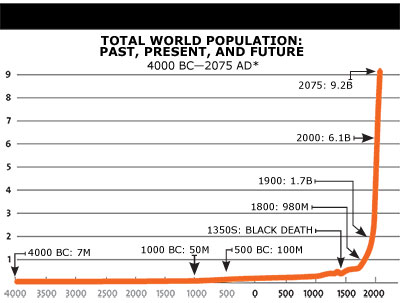 * Future figures based on UN projections. Sources: US Census Bureau, UThat so many can live among the ruins seems impossible. Yet so many do. The city is home to about 5 million people, at a population density of 70,000 per square mile—2.5 times more crowded than New York City. Another 9 million live in the urban agglomeration, bringing the population of greater Kolkata to 14 million. More are added every day—though not as many as you might expect from births. Kolkata’s fertility rate (the average number of children born to a woman) is only 1.35, well below the global replacement average of 2.34 (the number where population stabilizes as births balance with deaths). Instead, the city’s growth is fueled largely through migration from a poorer and more fertile countryside.
* Future figures based on UN projections. Sources: US Census Bureau, UThat so many can live among the ruins seems impossible. Yet so many do. The city is home to about 5 million people, at a population density of 70,000 per square mile—2.5 times more crowded than New York City. Another 9 million live in the urban agglomeration, bringing the population of greater Kolkata to 14 million. More are added every day—though not as many as you might expect from births. Kolkata’s fertility rate (the average number of children born to a woman) is only 1.35, well below the global replacement average of 2.34 (the number where population stabilizes as births balance with deaths). Instead, the city’s growth is fueled largely through migration from a poorer and more fertile countryside.
What supports the crowds of Kolkata are what supports life everywhere: air, water, food, fuel, climate. Three hundred miles north of the city rises the mighty buttress of the Himalayas, home to 18,000 glaciers covering an area of ice larger than Maryland. After the Arctic and Antarctic, this “third pole” holds earth’s greatest freshwater reserve, supplying the outflows of some of the globe’s mightiest rivers—Ganges, Yarlung Tsangpo, Brahmaputra—water for one in seven people on earth. Fifty miles to the south of Kolkata, at the end of those rivers, lies the enormous Bay of Bengal, where 3 million tons of seafood are netted, hooked, and trawled annually. In highlands to the north and south lie the seams of coal that fuel the city.
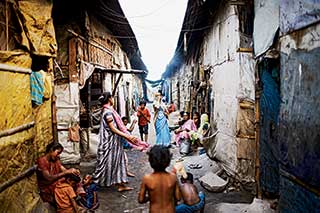 Konica Modol lives in Topsia, a Kolkata slum of shanties and godowns (warehouses). Days after these pictures were taken, fire consumed the slum, leaving 1200 homeless.Seen from above, the circulatory system of roads and railroads of the Indian east—home to 300 million people, roughly the same as the US—funnels into Kolkata, with trucks and freight trains running day and night, laden with fuel, fish, and food. The city itself funnels into a central core, a defensible bend in the Hooghly River and the classic star-shaped, 18th-century Fort William—a stronghold harking back to a time when wealth was measured in tea, silk, jute, ivory, and gemstones, and when survival was assured with cannon fire.
Konica Modol lives in Topsia, a Kolkata slum of shanties and godowns (warehouses). Days after these pictures were taken, fire consumed the slum, leaving 1200 homeless.Seen from above, the circulatory system of roads and railroads of the Indian east—home to 300 million people, roughly the same as the US—funnels into Kolkata, with trucks and freight trains running day and night, laden with fuel, fish, and food. The city itself funnels into a central core, a defensible bend in the Hooghly River and the classic star-shaped, 18th-century Fort William—a stronghold harking back to a time when wealth was measured in tea, silk, jute, ivory, and gemstones, and when survival was assured with cannon fire.
Survival in the 21st century is different. Its real measure lies in the depth of the snowpack in the Himalayas, in the sustainable tonnage of fish caught in the Bay of Bengal, in the inches of topsoil remaining on the Indian plains, and in the parts per million of coal smoke in the air. The root cause of India’s dwindling resources and escalating pollution is the same: the continued exponential growth of humankind.
As recently as 1965, when the world population stood at 3.3 billion, we collectively taxed only 70 percent of the earth’s biocapacity each year. That is, we used only 7/10 of the land, water, and air the planet could regenerate or repair yearly to produce what we consumed and to absorb our greenhouse gas emissions. According to the Global Footprint Network, a California think tank, we first overdrew our accounts in 1983, when our population of nearly 4.7 billion began to consume natural resources faster than they could be replenished—a phenomenon called “ecological overshoot.” Last year, 6.8 billion of us consumed the renewable resources of 1.4 earths.
The United Nations projects that world population will stabilize at 9.1 billion in 2050. This prediction assumes a decline from the current average global fertility rate of 2.56 children per woman to 2.02 children per woman in the years between 2045 and 2050. But should mothers average half a child more in 2045, the world population will peak at 10.5 billion five years later. Half a child less, and it stabilizes at 8 billion. The difference in those projections—2.5 billion—is the total number of people alive on earth in 1950.
The only known solution to ecological overshoot is to decelerate our population growth faster than it’s decelerating now and eventually reverse it—at the same time we slow and eventually reverse the rate at which we consume the planet’s resources. Success in these twin endeavors will crack our most pressing global issues: climate change, food scarcity, water supplies, immigration, health care, biodiversity loss, even war. On one front, we’ve already made unprecedented strides, reducing global fertility from an average 4.92 children per woman in 1950 to 2.56 today—an accomplishment of trial and sometimes brutally coercive error, but also a result of one woman at a time making her individual choices. The speed of this childbearing revolution, swimming hard against biological programming, rates as perhaps our greatest collective feat to date.
But it’s not enough. And it’s still not fast enough. Faced with a world that can support either a lot of us consuming a lot less or far fewer of us consuming more, we’re deadlocked: individuals, governments, the media, scientists, environmentalists, economists, human rights workers, liberals, conservatives, business and religious leaders. On the supremely divisive question of the ideal size of the human family, we’re amazingly united in a pact of silence.
“Overpopulation, combined with overconsumption, is the elephant in the room,” says Paul Ehrlich, 42 years after he wrote his controversial book, The Population Bomb. “We don’t talk about overpopulation because of real fears from the past—of racism, eugenics, colonialism, forced sterilization, forced family planning, plus the fears from some of contraception, abortion, and sex. We don’t really talk about overconsumption because of ignorance about the economics of overpopulation and the true ecological limits of earth.”
Core differences about how the population issue is viewed have reinforced the paralysis. Conservationists tended to frame the issue as people vs. nature, while human rights activists found this analysis simplistic and even racist, failing to address what they saw as the core problems of poverty and environmental injustice. Yet they in turn have tended to deny the limits of growth. Add the tension between rich and poor nations, and the issue quickly becomes radioactive. “In the developing world,” says Kavita Ramdas, the president and CEO of the San Francisco-based Global Fund for Women, “the problem of population is seen less as a matter of human numbers than of Western overconsumption. Yet within the development community, the only solution to the problems of the developing world is to export the same unsustainable economic model fueling the overconsumption of the West.”
I’m returning to India, where the dynamics of overpopulation and overconsumption are most acute, where the lifelines between water, food, fuel, and 1.17 billion people—17 percent of humanity subsisting on less than 2.5 percent of the globe’s land—are already stretched dangerously thin. India’s population is projected to surpass China’s by 2030 in a country only a third China’s size—adding 400 million citizens between now and 2050. But that’s the mid-level projection. A slight uptick in global fertility, and it may be home to a staggering 2 billion people by 2050. Here, before anywhere else on earth, the challenges of 20th-century family planning will become a 21st-century fight for survival.
Eden Hospital is a 19th-century marble marvel hidden behind spindly bamboo scaffolding at Kolkata’s Medical College. Its threshold is swamped by an outpouring of families, each shielding a mother and a swaddled newborn. It takes me a while to ford the flood. Inside, up an ancient, dark, and gritty central stairway, down a veranda lined with multi-bed wards and separated by jalousie doors hanging from rusted hinges, my mother was born 80 years ago, as were many of my relatives before and after her.
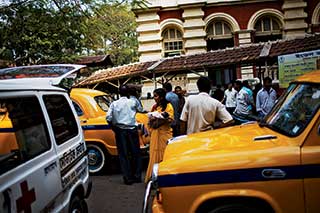 Eden Hospital was founded in 1881 as a maternity ward for Europeans—and for the Eurasian offspring of British colonialists and Indian women.Eden maternity hospital was a wonder in its day, opened optimistically in 1881 to accommodate some 80 women, primarily Europeans and Anglo-Indians: the biracial Eurasian community sired by the Raj. In 1881, there was an understanding that human population was growing, thanks to the Reverend Thomas Robert Malthus’ 1798 An Essay on the Principle of Population. Malthus, a political economist, argued that humans were destined to grow geometrically, while food production could increase only arithmetically, guaranteeing that famine would cinch the growth of humankind within the scarce purse of resources.
Eden Hospital was founded in 1881 as a maternity ward for Europeans—and for the Eurasian offspring of British colonialists and Indian women.Eden maternity hospital was a wonder in its day, opened optimistically in 1881 to accommodate some 80 women, primarily Europeans and Anglo-Indians: the biracial Eurasian community sired by the Raj. In 1881, there was an understanding that human population was growing, thanks to the Reverend Thomas Robert Malthus’ 1798 An Essay on the Principle of Population. Malthus, a political economist, argued that humans were destined to grow geometrically, while food production could increase only arithmetically, guaranteeing that famine would cinch the growth of humankind within the scarce purse of resources.
And so it did. For 150 years after Malthus, hunger killed millions: perhaps 50 million Chinese in multiple famines of the 19th century; upwards of 20 million Indians during a dozen major famines in the latter half of the 19th century; a million in the Great Famine of Ireland between 1845 and 1852; one-third of the local population in the Ethiopian Great Famine of 1888 to 1892; 3 million in Bengal in 1943.
Malthus’ mathematical concerns about population growth developed inside an 18th-century moral framework we still wrestle with today. According to him, poor people grew their numbers irresponsibly and were kept in check by their own bad habits and addictions: “The vices of mankind are active and able ministers of depopulation.” He opposed government assistance to the poor on the grounds that it enabled more people to reproduce without the means to support themselves. He advocated that the surplus population be allowed to decrease of its own accord—a suggestion that reportedly inspired Charles Dickens to pen the tale of misanthrope Ebenezer Scrooge.
In later editions of his essay, Malthus suggested a solution to the growing numbers of impoverished people he considered poor specimens, a eugenics-like answer popular in his time, based on animal husbandry and designed to “upgrade” the human race: “[B]y an attention to breed, a certain degree of improvement similar to that among animals might take place among men,” he wrote. “Whether intellect could be communicated may be a matter of doubt; but size, strength, beauty, complexion, and, perhaps, even longevity, are in a degree transmissible.”
My grandmother gave birth to six children in the airy rooms of Eden Hospital, exactly half the number born to her grandmother, who delivered 12 in half a dozen military outposts across India. These Eurasian children worried the leadership of imperial Britain, which oscillated between contradictory official policies allowing, discouraging, or mandating marriage between cohabiting British men and Indian women. Yet none of these early efforts at population (or complexion) control succeeded in stemming the flow of biracial children.
Part of the failure derived from a paradox in Malthus’ moral framework. The reverend believed families needed to limit their numbers of children, yet he opposed contraception, and many agreed with him. Only the “temporary unhappiness” of abstinence was acceptable. Other methods of birth control “lower, in the most marked manner, the dignity of human nature,” he wrote. “It cannot be without its effect on men, and nothing can be more obvious than its tendency to degrade the female character.”
Yet what Malthus put in motion could not be stopped. Fears of overpopulation spawned by his essay, combined with fears within families of too many hungry children, drove a 19th-century technological boom in contraceptives (including the invention of the first rubber condoms), known for a time as Malthusian devices. These were hardly the first attempts at birth control: Hieroglyphic instructions in ancient Egypt described vaginal plugs of crocodile dung; two millennia ago, a wild abortion-inducing fennel of the Mediterranean was harvested to extinction; a Greek legend described a female condom made of a goat’s bladder (for protection against the serpents and scorpions in King Minos’ semen); medieval Islamic physicians listed 196 contraceptive substances. (See “Masters of the Uterus.”)
Long before Malthus, humans sought to accommodate promiscuous intercourse without the entanglements of pregnancy. Even prior to the European discovery of rubber in the New World, men wore condoms: Chinese of oiled silk paper; Japanese of fine leather or tortoiseshell (both doubling as dildos for their women in their absence). Gabriele Falloppio tested linen condoms tied with ribbons on 1,100 Italian men in 1564 and claimed them to be 100 percent effective for men against the new plague of syphilis. Someone, though not the mythical Dr. Condom, discovered the intestines of goats, sheep, calves, and fish were prophylactic against both disease and pregnancy.
When all else failed, self-control helped. The men of Elizabethan England knew of and successfully practiced coitus interruptus, while the men of 18th-century France were so proficient at withdrawal that family size declined until the baby boom following World War II. The utopian Robert Dale Owen, attempting to promote coitus interruptus to prudish 19th-century Americans, labored through 48 pages of a profusely apologetic argument called Moral Physiology before zeroing in on what the French did so well: “It may be objected that [coitus interruptus] requires a mental effort and a partial sacrifice. I reply, that, in France, where men consider this…a point of honour, all young men learn to make the necessary effort.”
Even in Malthus’ time, pamphlets describing female contraceptive methods were circulating widely—though illegally in America, having been labeled pornographic. Informational leaflets such as the “diabolical handbills,” advising how to make and use vaginal sponges, were in high demand by European and American women who did not wish to rely on condoms or men. In 1871, writer Annie Besant and future English parliamentarian Dr. Charles Bradlaugh republished the underground American book, The Fruits of Philosophy, with advice on how to prevent pregnancy by douching after sex. Their showy obscenity trial—in which Charles Darwin refused to give evidence, and a conviction was overturned on a technicality—catapulted sales to 100,000. Soon after, many disparate fronts in the fight for the legalization of birth control coalesced around a new group catchily misnamed the Malthusian League.
No one knows how the Reverend Malthus managed to limit his own family to only three children. His teachings, however, sired countless errant progeny. For 25 years, he lectured at Britain’s East India Company College, where his ideas inspired a generation of male Britons to go forth and build a colonial empire. But since India was mostly bereft of European women, they also quickly peopled it with Eurasian offspring. Among the empire builders was a young Sir Ashley Eden, for whom the largest obstetrics and gynecological ward for Europeans and Eurasians in all of Asia would be named—leaving the vast majority of Indian women to Malthus’ version of nature’s ruthless devices.
India today prides itself on being the world’s largest democracy. But it’s also the hungriest, only recently and barely liberated from “the most dreadful famines” Malthus wrote of. One of every two underfed people on earth lives here. Forty percent of Indian children under the age of five are underweight and stunted. More than 4 percent of the 26 million babies born here every year die within their first month of life, a neonatal mortality rate surpassing even India’s war-torn neighbor, Sri Lanka. Worse, India’s underfed are not decreasing, as one might expect from one of the world’s fastest growing economies, but increasing. India’s economic boom has surged past most Indians, leaving 53 percent in poverty, according to the calculations of one Indian government commission. In the state of Bihar, next door to West Bengal, 9 of 10 rural children are anemic, a telltale marker of hunger and malnutrition.
In The Population Bomb, Ehrlich predicted inevitable mass starvation as early as the 1970s and 1980s—notably in India, which he claimed could not possibly attain food self-sufficiency. Instead, American agronomist Norman Borlaug’s “Green Revolution” brought dwarf wheat strains and chemical fertilizers to increase India’s crop yields 168 percent within a decade. This monumental achievement defused the bomb and earned Ehrlich the dismissive title of Malthusian: just one more in a line of pessimists forecasting phantom famines. Ever since, the subject has been largely taboo. Scientists from a variety of fields privately tell me the issue of overpopulation is simply too controversial—too inflamed with passions to get funded, too strong a magnet for ideologues. Those who’ve tackled it tell me of harassment, even physical threats, from a frightening fringe.
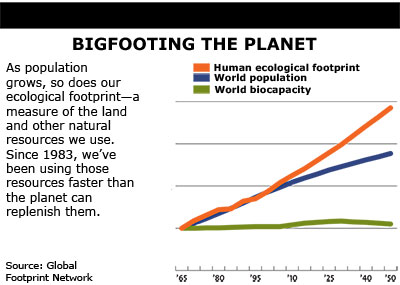 Take the near-civil war within the Sierra Club—whose former executive director, David Brower, originally suggested Ehrlich write The Population Bomb. The Sierra Club had long supported population stabilization. But started in the early 1990s, anti-immigration activists spurred by John Tanton—who controls an array of English-only, zero-immigration, and nativist groups—stealthily twice attempted to take over the board. Perhaps naively, some Sierra Club stalwarts concerned with population joined their cause. The battle lasted for a decade, culminating when Morris Dees of the Southern Poverty Law Center ran for Sierra’s board in an effort to expose Tanton’s true agenda—and the fact that one of his groups had accepted money from white supremacists. Ehrlich’s NGO Zero Population Growth then parted ways with Tanton (a past president), renamed itself the Population Connection, and embraced an end-poverty-to-curb-population approach. Ehrlich and his wife Anne, a conservation biologist, also left the board of Tanton’s Federation for American Immigration Reform. Yet the scars between environmentalists and the development community are only beginning to heal. “When you talk about population,” says Larry Fahn, Sierra Club president during some of the bitterest infighting, “the immigration people come out of the woodwork with their hate mongering. It’s unfortunate that the subject brings out a racist agenda.”
Take the near-civil war within the Sierra Club—whose former executive director, David Brower, originally suggested Ehrlich write The Population Bomb. The Sierra Club had long supported population stabilization. But started in the early 1990s, anti-immigration activists spurred by John Tanton—who controls an array of English-only, zero-immigration, and nativist groups—stealthily twice attempted to take over the board. Perhaps naively, some Sierra Club stalwarts concerned with population joined their cause. The battle lasted for a decade, culminating when Morris Dees of the Southern Poverty Law Center ran for Sierra’s board in an effort to expose Tanton’s true agenda—and the fact that one of his groups had accepted money from white supremacists. Ehrlich’s NGO Zero Population Growth then parted ways with Tanton (a past president), renamed itself the Population Connection, and embraced an end-poverty-to-curb-population approach. Ehrlich and his wife Anne, a conservation biologist, also left the board of Tanton’s Federation for American Immigration Reform. Yet the scars between environmentalists and the development community are only beginning to heal. “When you talk about population,” says Larry Fahn, Sierra Club president during some of the bitterest infighting, “the immigration people come out of the woodwork with their hate mongering. It’s unfortunate that the subject brings out a racist agenda.”
Abortion is even more toxically associated with population debates. “Many conservation and nongovernmental organizations that run on member support, even the big ones, shy away from the population issue,” says Ed Barry of the Population Institute in Washington, DC, a nonprofit founded in 1969 by a United Methodist Church minister. “That’s because it puts their funding at risk. Even if you’re talking about population as a sustainability issue, there’s often an automatic assumption you’ll be talking about abortion.”
Voiced or not, addressed or not, the problem of overpopulation has not gone away. The miracle of the Green Revolution, which fed billions and provided the world a sense of limitless hope, also disguised four ominous truths about earth’s limits. First, the revolution’s most effective agents, chemical fertilizers of nitrogen and phosphorus, are destined to run out, along with the natural resources used to produce them. Second, the fertilizers, pesticides, and herbicides that grew the food that enabled our enormous population growth in the 20th century bore expensive downstream costs in the form of polluted land, water, and air that now threaten life. Third, crop yields today are holding stubbornly stable and even beginning to fall in some places, despite increasing fertilizer use, in soils oversaturated with nitrogen.
The Green Revolution’s duplicitous harvest—giving life with one hand, robbing life-support with the other—also masked a fourth ominous truth. We’re running out of topsoil, tossing it to the wind via mechanized agriculture and losing it to runoff and erosion. Geomorphologist David Montgomery, author of Dirt: The Erosion of Civilizations and 2008 recipient of a MacArthur “genius” fellowship, calculates that human activities are eroding topsoil 10 times faster than it can be replenished. “Just when we need more soil to feed the 10 billion people of the future,” he says, “we’ll actually have less—only a quarter of an acre of cropland per person in 2050, versus the half-acre we use today on the most efficient farms.” Plus there’s little new land to bring into production: “We could, with crippling environmental costs, raze the Amazonian rainforests and reap 5 to 10 years of crops before the tropical soils failed. But the fertile prairies of the Midwest, northern China, and northern Europe are already plowed to capacity and shrinking.”
In India, the problem of peak soil is already acute. Nearly a quarter of its lands, more than 314,000 square miles, are desert or in the process of becoming desert, according to a recent Indian government report. Desertification will double India’s current water usage by 2030, as more water is rerouted to irrigate an increasingly drier landscape to grow rice, wheat, and sugar for an increasing population, including the growing demands of a growing middle class. McKinsey & Co., the global management consulting firm, forecasts severe deficits in water—and, by default, food—in India by 2030.
Combine peak oil and peak topsoil with global warming, and a study in the peer-reviewed journal Science predicts a 20 to 30 percent decline in crop yields in the next 80 years. Alarmingly, the process of photosynthesis itself declines precipitously as temperatures rise above 86 degrees Fahrenheit, making it increasingly difficult to maintain—let alone increase—crop yields. (The European heat wave of 2003 that killed up to 50,000 people also slashed crop harvests by as much as 36 percent.) Rising temperatures and the resulting drier landscapes will put our major food crops in the lower latitudes (including all of India) at risk in the near future. “I grow increasingly concerned that we have not yet understood what it will take to feed a growing population on a warming planet,” says Penn State biologist and lead author Nina Fedoroff. Furthermore, India’s “atmospheric brown cloud”—the smog that fouls the subcontinent between monsoons—could undermine crop yields by up to 40 percent. Not only is there more smog in Asia, but Asian crops appear more sensitive to smog than crops in North America or Europe, even crops of the same variety. No one knows why.
The UN calculates that 36 million die of hunger and malnutrition every year—a person every second, mostly women and children. Famine is no phantom, and history may yet remember Paul Ehrlich as the premature prophet, not the false one, his predictions off by decades rather than degree.
JUST AS THE festival of Durga Puja ends, another winds up. Kali Puja is Kolkata’s other favorite celebration of a goddess, this one the violent agent of change for whom the city is named. The flower business is exploding at Malik Ghat, the city’s oldest wholesale flower market. Hundreds of vendors, buyers, and tokriwallahs (basket carriers) shuffle through the narrow lanes overflowing with miles of garlands of orange and yellow marigolds, and tons of red hibiscus, white gardenias, greenery.
Squeezed into the crowds, I’m a head taller than many people, and far taller than some, though I measure only 5 feet 8 inches. Many of the people around me are tiny and slight, even the men, with delicate bones in wrists and ankles, as if they could, like birds, take flight. Here and there a fat, wealthy matron appears, plowing through the crowd like an errant iceberg riding a deeper, faster current, her sari glittering with woven gold. I’m struck by how some of us are literally siphoning the flesh and blood from the rest of us, segregating ourselves into beings so calorically and structurally different that paleontologists of the distant future might well classify our fossilized skeletons as separate species.
The problem is long in the making. Ever since Homo sapiens invented agriculture, we’ve sported super-prolific birth rates, counterbalanced by brutishly short life expectancies averaging a mere 10 years. We bred and died in boom cycles busted by famines, natural disasters, diseases, and violence. Beginning around 500 AD, we suffered centuries of bust, ravaged by the Black Death and its piggybacking disasters sweeping west from Asia—the last check on our growth. Nothing since then, not the lethal 20th century, with two world wars, an influenza pandemic, and the emergence of HIV/AIDS, has reversed our growth. (See chart above.)
Driven by inescapable biology that seduces us with the joys of sex, we populate, and then some. We plan our families. Or we don’t. Two hundred million women have no access whatsoever to contraception, contributing to the one in four unplanned births worldwide and the 50 million pregnancies aborted each year, half of them performed clandestinely, killing 68,000 women in the process. As for the conventional wisdom that poor rural couples actively plan to have large families because of high child mortality or to provide for their care in old age, not true, says John Guillebaud, emeritus professor of family planning and reproductive health at University College, London. Instead, poor people have large families simply because they, like most of us, have sex many, many times in their lifetimes and some of those times, or even all of those times, they do not have, or do not use, contraceptives, or their contraceptives fail. “For a fertile couple, nothing is easier,” says Guillebaud.
Planned or not, wanted or not, 139 million new people are added every year: more than an entire Japan, nearly an entire Russia, minus the homelands and the resources to go along with them. Countered against the 56 million deaths annually, our world gains 83 million extra people every year, the equivalent of another Iran. That’s 1.6 million more humans alive this week than last week and 227,000 more people today than yesterday—all needing food, water, homes, and medicine for an average lifespan of 69 years. We are asking our world to supply an additional 2.1 trillion human-days of life support every single year. Eventually, most of these 83 million new people added every year will have kids, too.
Understood or not, the exponential growth model—also known as the Malthusian growth model—runs in the background, amplifying our childbearing choices. In a new twist on the downstream effects, statistician Paul Murtaugh of Oregon State University decided to investigate the environmental price tag of a baby. “Suddenly we can gauge our carbon emissions from all kinds of lifestyle choices, like cars, appliances, and airplane flights,” he says. “But there’s no calculator computing the carbon emissions of a child—and her children, and her children.” (Murtaugh ran the statistical analysis on mothers, because following lineages of both parents was computationally prohibitive.)
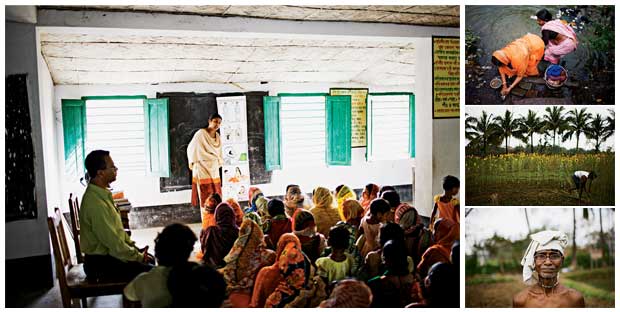 Scenes from rural Bengal, where a microloan program called Bandhan teaches women basic hygiene and sex education. The result is a revolutionary way to battle poverty and disease.
Scenes from rural Bengal, where a microloan program called Bandhan teaches women basic hygiene and sex education. The result is a revolutionary way to battle poverty and disease. 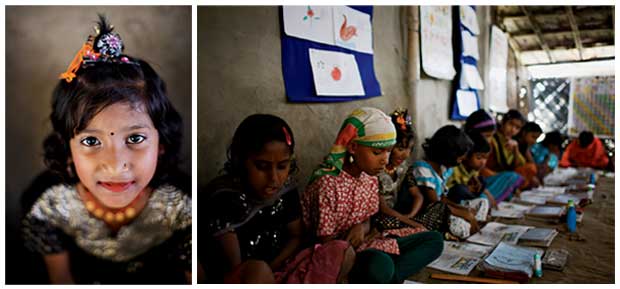 Girls in a Bandhan primary school.“The results surprised me,” he says. “Using United Nations projections of fertility, and projecting statistically through the lifespan of the mother’s line—some lineages being short-lived, others indefinitely long—an American child born today adds an average 10,407 tons of carbon dioxide to the carbon legacy of her mother. That’s almost six times more CO2 than the mother’s own lifetime emissions. Furthermore, the ecological costs of that child and her children far outweigh even the combined energy-saving choices from all a mother’s other good decisions, like buying a fuel-efficient car, recycling, using energy-saving appliances and lightbulbs. The carbon legacy of one American child and her offspring is 20 times greater than all those other sustainable maternal choices combined.” (See chart [“Little Bundle of Carbon”].)
Girls in a Bandhan primary school.“The results surprised me,” he says. “Using United Nations projections of fertility, and projecting statistically through the lifespan of the mother’s line—some lineages being short-lived, others indefinitely long—an American child born today adds an average 10,407 tons of carbon dioxide to the carbon legacy of her mother. That’s almost six times more CO2 than the mother’s own lifetime emissions. Furthermore, the ecological costs of that child and her children far outweigh even the combined energy-saving choices from all a mother’s other good decisions, like buying a fuel-efficient car, recycling, using energy-saving appliances and lightbulbs. The carbon legacy of one American child and her offspring is 20 times greater than all those other sustainable maternal choices combined.” (See chart [“Little Bundle of Carbon”].)
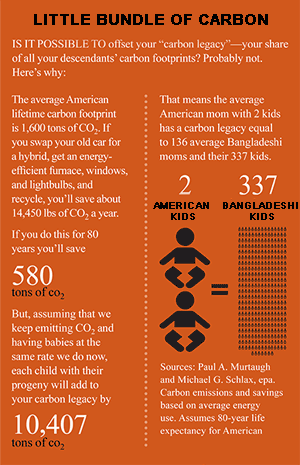 Murtaugh’s research shows that even though India has a much larger population and a higher rate of population growth than the US, its overall carbon legacy is vastly reduced, due to its population’s drastically lower levels of consumption combined with shorter lifespans (63.8 years on average for India, versus 80.2 years for the US). At current rates, an American child has 55 times the carbon legacy of a child born to a family in India. While India is conservatively predicted to grow by 400 million people by 2050, the US is projected to grow by 86 million. But take those additional Americans and factor in their 55-times-higher carbon legacy (at current national consumption rates), and they will equal the legacy of 4.7 billion Indians.
Murtaugh’s research shows that even though India has a much larger population and a higher rate of population growth than the US, its overall carbon legacy is vastly reduced, due to its population’s drastically lower levels of consumption combined with shorter lifespans (63.8 years on average for India, versus 80.2 years for the US). At current rates, an American child has 55 times the carbon legacy of a child born to a family in India. While India is conservatively predicted to grow by 400 million people by 2050, the US is projected to grow by 86 million. But take those additional Americans and factor in their 55-times-higher carbon legacy (at current national consumption rates), and they will equal the legacy of 4.7 billion Indians.
“The irony,” says Ramdas of the Global Fund for Women, “is that just as some Americans are starting to learn to live more like traditional Indians—becoming vegetarian, buying locally, eating organic—aspiring middle-class Indians are trying to live more like overconsuming Americans. The question really is, which kind of people do we want less of?”
FROM HER MODEST apartment off Elliot Road in old Calcutta in the 1930s and ’40s, my impoverished, generous, gregarious, and free-thinking grandmother was a go-to authority for girls or women in trouble. They visited her in secrecy, teary or resolute, alone or with a mother, sister, or friend towing them by the hand. The problem was a boyfriend or a husband or too many children or a secret affair or incest. The solution lay in my grandmother’s rare network of connections spanning the Eurasian, Indian, and British communities. She listened and consoled, scolded as she deemed fit, then advised where to go, who to see, and how to come up with the money for a survivable abortion.
Like most Eurasians in India, my grandmother was forced to live outside both Indian and British societies, compelled to leave home and earn wages long before either British or Indian women—in effect, pioneering a vast course change that would span the breadth of the 20th century and beyond. The three of six children that my grandmother lost to early deaths were part of the seesawing changes between fertility and mortality that saw India’s population quadruple between 1901 and 2001. Looking back now, we can see that India’s population course in the 20th century took a surprisingly predictable path—because we know what Thomas Robert Malthus could not know: that nations wend through multiple stages of a demographic transition on their way to and through industrialization.
Until the late 18th century, everyone everywhere subsisted in the nasty, brutish, and short conditions of stage one: extremely high birth rates coupled with extremely high death rates, resulting in slow population growth. Malthus himself lived through Britain’s stage two: the onset of urbanization and industrialization and a true population explosion, as birth rates leveled but death rates plunged dramatically. Stage two first occurred in northern Europe and was spawned (ironically, despite Malthus’ fears) by more and better food: the superior nutrition of corn and potatoes imported from the Americas, and an agricultural revolution brought on by scientific advances in farming. Stage two was also triggered by a revolution in our understanding of disease, which led to better handling of water, sewage, food, and ourselves. The primary driver behind this new science of hygiene was increased literacy among women, who wrote and read health-education pamphlets, and who managed the daily cleanliness of families and hospitals.
India today is navigating stage three, as fertility rates drop closer to death rates. Stage three includes a contraceptive revolution, different in every time and place: in Europe 200 years ago, a revolution of coitus interruptus and condoms; in India today, birth control pills and, often, sterilization after the first son is born. This pivotal phase coincides with profound cultural changes, as women end their isolation in the home to enter the workplace and network with other women. Wage-earning women claim more responsibility for childbearing and child-rearing decisions, leading to a revolution in children’s lives, as the decision is made to pay for schooling—a costly choice necessitating smaller families. This choice is strongly influenced by female literacy, since women who can read even slightly are more likely to send their daughters to school.
In India today, 75 percent of men are literate, compared to only 54 percent of women—one of the most lopsided ratios among newly industrialized nations. The statistic corresponds directly to fertility. In the state of Bihar, next door to West Bengal, where literacy falls below the national average—to 60 percent for males and 33 percent for females—the total fertility rate swings up to four children per woman. Conversely, the southern Indian state of Kerala, which boasts 94 percent male literacy and 88 percent female literacy, has reached a below-replacement-rate fertility that resembles the industrialized world’s, at only 1.9 children per woman.
Whether we are a world of 8, 9.1, or 10.5 billion people in 2050 will be decided in no small part by the number of illiterate women on earth. Of the more than 1 in 10 people who can’t read or write today, two-thirds are female. Locate them, and you’ll find an uncannily accurate roadmap of societal strife—of civil wars, foreign wars, the wars against reason embedded in religiosity, the wars against equality ingrained in patriarchal and caste systems.
Sheryl WuDunn, the Pulitzer Prize-winning coauthor (along with her husband, New York Times columnist Nicholas Kristof) of Half the Sky: Turning Oppression Into Opportunity for Women Worldwide, explains: “When women are educated, they tend to marry later in life, to have children later in life, and to have fewer children. In effect, you have a form of population control that’s peaceful, voluntary, and efficient. Plus, educated women do better in business, raising economic growth rates, and lowering societal conflict. If we could achieve universal literacy for women, we’d have a much better shot at peace around the world.”
Some call the power of empowering women “the girl effect,” and it is uniting the once-divided conservation and human rights communities in common cause. A model of it, developed in Bangladesh and West Bengal, is beginning to ripple out through India’s 565 million women. I’m chasing the tendrils of this through the outskirts of Bagnan in West Bengal, a farm town inhabiting the low-lying landscape between the Rupnarayan and Damodar rivers. The countryside here has been sculpted by centuries of human use: seasonal wetlands excavated into a patchwork of rainwater ponds and rice paddies, the diggings compiled to afford a few feet of livable clearance above flood level.
I’m trailing Soumitra Dutta, a physician and consultant to Freedom From Hunger, a California nonprofit at the forefront of grafting health care and education onto microloans. Dutta, in turn, is trailing Trideep Roy and Nabanita Mondal, employees of a Bengali microlender, Bandhan (“togetherness”). We step over cloths full of drying rice, dodge foraging hens, duck under low-hanging laundry, weave between sleeping dogs, sidestep trails of hay edging the paths and the placid, dung-producing cows feeding on them. We pass clusters of houses shared by extended or multiple families, each painted orange, red, or green. On the walls, circular brown patties of cow dung, India’s rural fuel source, are drying in the sun. Each is imprinted with a woman’s or child’s slender fingerprints.
We’re welcomed at a small green house by Supta Halder, a tiny woman wearing a bright pink sari and an air of authority. She ushers us into the back room of her two-room house and invites us to sit on the bed. Five years ago, her family could not live in this room, she explains. The roof leaked. The walls were crumbling. Nor could they farm a parcel of land inherited by her husband, a teacher. Unable to adequately feed themselves, the family struggled with relentless poverty and poor health.
So it had been since time immemorial, and so it might have continued into the foreseeable future. Except the plot took a twist in the form of a tiny loan of $42 offered in 2004 to Halder from Bandhan. With that money, and with four subsequent loans eventually totaling $780, Halder began to repair her house, more than doubling her usable square footage. She reconditioned her husband’s acre of land, building a pond for collecting monsoon water to farm fish and to water her new crops of rice and flowers. She developed a business, buying wholesale saris in Kolkata, riding the train three hours each way, and bringing them home to sell to the women of Bagnan, many of whom were also receiving Bandhan loans, growing businesses, and finding themselves with the unfamiliar pleasure of disposable income.
Supta Halder estimates her age at 43 or 44. The fruits of her many labors are visible in this multipurpose room: the new television and VCR, the new bed frame—even her daughter-in-law, preparing us refreshments in the next room, married to Halder’s son only a year ago, in a match likely facilitated by the improved prospects of the Halder family. Halder’s energy is barely contained within her small frame and the swirl of her sari. In my world, she’d probably be a CEO—or knocking herself out against the glass ceiling.
Her daughter-in-law offers us stainless-steel cups of water, elegantly presented on a tray. I smile, then hesitate, stalled at the crossroad between etiquette and experience.
“It’s okay,” Dutta assures me. “It’s water from the tube well.”
The nearby tube well delivers clean water from an underground aquifer via a hand pump—a fairly recent development in rural West Bengal, where people have traditionally drunk, bathed, and swum alongside their livestock in the ponds of monsoon water, unknowingly afflicting themselves with everything from chronic diarrhea to hookworm to dysentery to typhoid. Halder has only recently begun using water from the tube well—thanks to a pilot program initiated by Freedom From Hunger.
“When we investigated why women default on their microloans,” says Marcia Metcalfe, FFH’s director of microfinance and health protection, “we discovered the problem was almost always due to a health crisis in the family. Women will abandon their jobs and their loans to care for a sick family member. Investigating further, we learned that many of these illnesses were preventable or easily curable. So we began to design a program to treat those problems.”
Two years ago, Halder received a health education course funded by FFH and staffed by Bandhan. Since then, she’s trained her family to use tube-well water for drinking, washing the dishes, and rinsing themselves after bathing in the pond. (Although half the tube wells in West Bengal are contaminated with unsafe levels of arsenic—caused by irrigation and the rainwater ponds—Halder’s tube well is clean. For others, the answer to clean, safe water lies in different pumping techniques or in deeper wells.) Halder has also used some of her loan money to build a sanitary pit toilet, replacing the ancient rural custom of fertilizing the fields after dark. She’s taught the family to wear sandals to the toilet to prevent hookworm infestation—its iron-deficiency anemia is a contributing factor in maternal and child death here—and to wash their hands afterward.
These modest changes have transformed chronic sickness into good health that’s rippled far beyond the family’s two rooms. Halder explained the basics of sanitation to her own siblings and her three married daughters in distant villages, all of whom changed their own families’ ways. Her neighbors noticed the Halders’ improved health and followed the lead, and the hygienic revolution rippled outward.
“We even wondered about our cows,” says Halder. “They were emaciated from diarrhea. So we gave them tube-well water and now they’re healthy, too.”
The water in my steel mug at Supta Halder’s house is flavored with isabgol, the psyllium seed husks traditionally used as a digestive aid in India—the same ingredient in Metamucil, recognizable by the sweet taste and slightly slimy texture. I smile, silently toasting Supta Halder’s achievements with a glass of laxative.
Halder was recently elected sastho sohayika (“health helper”) by her fellow Bandhan loan recipients. This is a new role in the village and another FFH health initiative, designed by Dutta and implemented through Bandhan. As a sastho sohayika, Halder has been trained to assess the basic medical needs of her fellow villagers. Government care is available. But the nearest clinic is miles away, and hospitals are even farther.
Trideep Roy, assistant manager for the Bandhan health program in Bagnan, explains that rural villagers rarely know when their condition warrants a trip to the clinic. Furthermore, families will usually pay for medical care only for the man of the family—even though women of childbearing age and beyond, as well as children, tend to need care more frequently.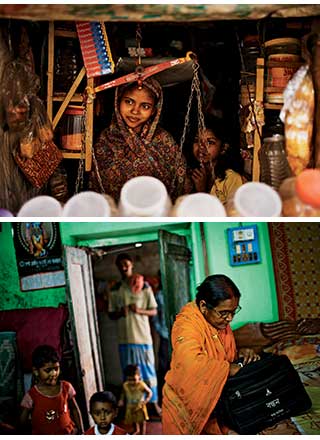 Bandhan microloans have allowed Rehana Bibi and Supta Halder to radically alter their families and communities.
Bandhan microloans have allowed Rehana Bibi and Supta Halder to radically alter their families and communities.
Supta Halder is on call around the clock. If a patient needs more than she can provide, she contacts Nabanita Mondal, a Bandhan health care officer, who oversees 30 sastho sohayika and is trained to refer patients to the government system. Halder doesn’t earn any money as a sastho sohayika. Instead, she has access to a small pharmacy of common health care products—antacids, aspirin, oral rehydration solution, deworming medication, antibacterial soap, and birth control pills—which she sells to patients for a small profit. These products are available at government health clinics, often for free. But the clinic is far and often unreliable: closed when it’s supposed to be open, or plagued by empty shelves. Halder’s home visits also allow women to shop in private—like an Avon lady with contraceptives.
Halder says the sastho sohayika position has increased her standing with her family and in the community, although she’s aware that if she makes a wrong call the consequences to her reputation, even her well-being, could be serious. Nevertheless, she loves her work. When I ask how these changes of the past five years—the loans, the jobs, the income, the health care expertise—have changed her family life, Halder offers a concise answer, which Dutta translates as “much better.” Asked what her husband thinks of all the changes, she smiles and says he’s very happy with their new life.
THE UPSTAIRS classroom in Bagnan’s Goalberia Primary School is crowded with colors so clashing they harmonize: Chrome yellows, turquoises, fuchsias, fire-engine reds, and iridescent greens adorn the saris and shirts draped on some 50 women and children. The people gathered here are so restless, nervous, and shy, hidden behind such bright fluttery fabrics, that I feel as if I’ve stepped into a room full of exotic butterflies.
This is a Muslim community in Bagnan. Many of the women here are recipients of Bandhan loans. As is often the case, the forum coincides with the due date on loan repayments—since this is the day every month these women gather anyway (though all are welcome at the health forum, male or female). The women are eager and attentive, focusing on today’s lesson taught by Nabanita Mondal—a pretty young mother wearing stylish eyeglasses and a salwar kameez, the long tunic and pants that constitute the working uniform of modern Indian women. The lecture is the 20th of 24, and the first of a two-part series on HIV/AIDS.
 Bandhan Chairman Chandra Shekhar Ghosh took the hard lessons of his own upbringing to develop a program that serves 2 million women.“Who knows about this disease?” Mondal asks. Only five women raise their hands—although one young woman stands to deliver a comprehensive lecture in a confident voice. Soumitra Dutta, translating for me, is impressed by her knowledge and asks where she learned this. At the hospital, she says.
Bandhan Chairman Chandra Shekhar Ghosh took the hard lessons of his own upbringing to develop a program that serves 2 million women.“Who knows about this disease?” Mondal asks. Only five women raise their hands—although one young woman stands to deliver a comprehensive lecture in a confident voice. Soumitra Dutta, translating for me, is impressed by her knowledge and asks where she learned this. At the hospital, she says.
Today’s lesson is taught with a single tool, a drop-down poster with five cartoon images, designed for those who are illiterate. The drawings depict an infected man alongside an identical-looking uninfected man, the insides of a human body with a man firing an assault rifle at cells, a gaunt patient in a hospital bed, a naked man and woman in bed, and a composite image of a hypodermic needle, a blood transfusion, and a mother breastfeeding.
These lectures are Dutta’s brainchild, designed during a hard year of field testing with FFH and Bandhan resources. The curriculum covers everything from birth control to pre- and postnatal care, breastfeeding, child nutrition, maternal nutrition, and hygiene. He confesses he was worried when he heard that Trideep Roy and Nabanita Mondal would be bringing me to Goalberia to see his program in action, worried the women might be too shy to be responsive. But it’s clear these mothers, wives, sisters, and daughters—initially so distracted by my presence, and now focused powerfully on the lesson—are hungry for this education.
Dutta tells me that Bandhan recently opened an office in the extremely poor, densely populated, and predominantly Muslim city of Murshidabad, 120 miles from here, where female literacy is only 36 percent, the fertility rate is around 10, says Dutta, and child labor and malnutrition are rife. The services provided by the FFH/Bandhan symbiosis—the loans, the visits of a sastho sohayika, the health forums—may be the only means for these women to gain any control over their futures.
“Even though oral contraceptives are available for free or nearly free in Indian public health centers,” says FFH’s Metcalfe, “Bandhan health officers sell to more women in their homes than the government reaches. This is particularly true for Muslim women, whose lives may be more limited than Hindu women, and for whom privacy is an intensely important issue.”
“Already it’s working,” adds Dutta. “And if it can work in Murshidabad, it can work anywhere.”
THE BEST FAMILY plans, the best intentions of any woman, can be waylaid by her government, since politics control fertility with godlike powers. In 2003, the predominantly Catholic Philippines bowed to church demands to support only “natural family planning”—otherwise known as the rhythm method, and grimly referred to as Vatican roulette. (See “Close Your Eyes and Think of Rome.”) The Filipino government no longer provides contraceptives for poor Filipinas, and government clinics no longer distribute donated contraceptives, including the wealth of modern birth control once provided by the US Agency for International Development. (Filipina Health Secretary Esperanza Cabral, however, continues defiantly to distribute free condoms to combat rising HIV infection rates.)
Today more than half of all pregnancies in the Philippines are unplanned—10 percent more than a decade ago. In a first-of-its kind study in the Philippines, the Guttmacher Institute calculates that easy access to contraception would reduce those births by 800,000 and abortions by half a million a year. Furthermore, it would deliver a net savings to the government on the order of $16.5 million a year in reduced health costs from unwanted pregnancies, including the brutal medical consequences of illegal back-alley abortions.
In Iran, the fertility pendulum has gone the other way in recent years. From a high of 7.7 in 1966, total fertility fell to 6 during the Shah’s reign, spiked to 7 during the Islamic Revolution (when marriage became legal for 12-year-old boys and 9-year-old girls), then plummeted 50 percent between 1988 and 1996, continuing down to 1.7 today. That plunge, known as the “Iranian miracle,” was one of the most rapid fertility declines ever recorded.
Iran’s demographic reversal was swift, uniform, and voluntary. Women of all childbearing ages in urban and rural parts of the country simply began to have smaller families practically overnight. Demographer Mohammad Jalal Abbasi-Shavazi of the University of Tehran writes that the feat was engineered through a mobilization between government and media: Information was broadcast nationwide about the value of small families, followed up with education about birth control, implemented with free contraceptives. Progressive social measures further primed Iran: increasing public education for girls (today more than 60 percent of Iranian university students are women); a new health care system; access to electricity, safe water, transportation, and communication. Similar fertility reversals have occurred in Costa Rica, Cuba, South Korea, Taiwan, Thailand, Tunisia, and Morocco—as quickly as in China but minus the brutal one-child policy.
The United States, plagued by its own ping-pong policy, has been little help. Beginning with Ronald Reagan in 1984, the “global gag rule,” also known as the Mexico City Policy, prohibited US funding of any foreign family planning organizations providing abortions. The gag rule barred the discussion of abortion or any critique of unsafe abortions, even if these medical services were implemented with the group’s own money (a ruling that would have been unconstitutional in the US). Bill Clinton rescinded the policy in 1993, but George W. Bush reinstated it in 2001, and before Barack Obama could rescind it again, the flow of aid to developing countries slowed or even stopped, eviscerating health care and severely undermining family planning efforts in at least 26 developing nations, primarily in Africa.
Joanna Nerquaye-Tetteh, former executive director of the Planned Parenthood Association of Ghana, testified before Congress in 2004 on the policy’s effects in her country. “The gag rule completely disrupted decades of investment in building up health care services,” she said. “We couldn’t provide contraceptives and services to nearly 40,000 women who had formerly used our services. We saw within a year a rise in sexually transmitted infections and more women coming to our clinics for post-abortion care as a result of unsafe abortions.”
Although it’s unclear how many babies were added to the human family as a result of the global gag rule, the UN estimates that at its height in 2005, the unmet demand for contraceptives and family planning drove up fertility rates between 15 and 35 percent in Latin America, the Caribbean, the Arab states, Asia, and Africa—a whole generation of unplanned Bush babies.
IN AN UPSCALE Kolkata suburb, I meet with Chandra Shekhar Ghosh, founder and chairman of Bandhan, a tall man with crooked eyeglasses and a straightforward smile. He speaks quietly of his father, a hardworking Bengali who owned a sweet shop that prospered modestly in good times and was among the first to suffer in bad times. “My mother did not work outside the home and could not help financially when times got tough,” he says. “From a young age, I realized the inflexibility of this model in an ever-changing world and vowed to change it.”
Sitting in with us is one of his finance managers, Maneeta Rathore, a bubbly young woman who shares the same devotional enthusiasm I saw among the staff in Bandhan’s field office in Bagnan, where Trideep Roy, Nabanita Mondal, and the loan officers work and live during the week. Many Bandhan staff members are stationed so far from home that they manage to return to their families only once or twice a month. Nevertheless, Ghosh’s people wear an aura of pride and purpose and a happiness not the norm among taciturn Bengalis, the New Yorkers of India.
When Ghosh opened the first Bandhan branch office in 2002 in Bagnan, he slept on the floor for months at a time, Soumitra Dutta tells me. Maneeta Rathore says Ghosh couldn’t get a single banker to listen to him back then, and now they’re knocking at his door. In only eight years, he has grown his hope for the poor from a single field office in Bagnan to more than a thousand field offices serving more than 2 million female clients in 14 Indian states. Two years ago, Forbes magazine voted Bandhan the No. 2 microfinance institute in the world based on size, efficiency, risk, and return.
Ghosh is not the original microloan pioneer. That credit goes to Bangladeshi Muhammad Yunus, who founded Grameen (“villages”) Bank in 1983. His revolutionary model was to loan to the unloanable poor—notably women—who lacked collateral, enabling them to develop their own businesses and free themselves from poverty. This radical innovation won Yunus the Nobel Peace Prize in 2006. Empirical studies now support his intuition of 27 years ago: Women make better loan recipients than men if your aim is to increase family well-being. Compared to men’s loans, women’s loans double family income and increase child survival twentyfold.
Ghosh is bringing this program into the 21st century by adding the health forums and the sastho sohayika program, as well as an initiative called Targeting the Hard Core Poor, aimed at those who can’t meet the requirements for a microloan. “These are the homeless and the downtrodden,” he says. “The widows with children who beg for a living and who have no resources and no confidence. Rather than money, we give them an asset, a milk goat or cow or a roadside tea stall. We guide them through about 18 months of business development before they graduate into the microloan program.”
At the outset of our meeting, Ghosh makes a point of telling me there is no peace in money, no peace when others suffer, but peace only when everyone shares in it. When I ask if he imagines expanding his help for the poor beyond India, he says yes, but won’t reveal where. I suggest he try the US, likewise home to impoverished people unable to procure credit or health care—people whom no one believes in. He blinks, surprised. Then giggles.
IT’S DARK AT 4:30 in the morning near Darjeeling, the city of tea in the Himalayas. Nevertheless, 2,000 people are gathered at 8,500 feet atop Tiger Hill awaiting the cold sunrise. The crowd, milling in the dark, sipping chai from tiny throwaway plastic cups, speaks more than a few of India’s 1,600 dialects and wears more than a few of its traditional clothes mashed up with western sweaters, counterfeit “North Phase” parkas, and hiking boots.
The department of tourism has built a pavilion on Tiger Hill for viewing the sunrise. Its three stories provide an apt metaphor for one version of our future world. The top floor, the “super deluxe lounge with complimentary tea,” is enclosed within glass picture windows ideal for viewing. It seats about 50 people, or 2.5 percent of the crowd, in pink plush chairs and sofas, at a cost of 40 rupees (87 cents) to enter. The other two floors, which make up the “deluxe” lounge, charge half as much to house four times as many people, about 10 percent of the crowd, at a fraction of the comfort level and without the free tea. The remaining 1,750 people—87.5 percent—pay 5 rupees (10 cents) to stand outside in the cold.*
Perhaps somewhere out in the shivering crowd is a Supta Halder or two—a lucky, hardworking woman who’s benefited from the help and education she’s received. Her descendants will prosper, perhaps enough to watch the sunrise from the deluxe lounge. Fed better in childhood, they will grow taller and live longer. Better educated, they will have fewer children, whom they will also educate and who will marry later, also to bear fewer, taller, plumper, longer-living offspring. The best 21st-century contraceptive is a Yunusian device, a microloan.
The business of microloans is growing exponentially. Between March 2008 and March 2009, 22.6 million people in India received them, 60 percent more than a year earlier, despite the worst global recession since the Great Depression. This innovative approach to development is rewriting the demographics of poverty. It’s also selling the loan recipients bigger ecological shoes—televisions, VCRs, larger homes, cars—though they’re still nowhere near the size of Western shoes.
Rajendra Pachauri, cowinner of a Nobel Prize for his chairmanship of the Intergovernmental Panel on Climate Change, warns that India’s growing population can’t afford increased consumption levels. “We can’t support lifestyles even remotely like those in Europe and North America,” he says. “We need policy initiatives to assure this doesn’t happen. But the movement has to take place in both hemispheres. Awareness has to be raised in both the East and the West to deglamorize unsurvivable consumerism.”
On the top floor of the Tiger Hill Pavilion, the people in the super deluxe lounge are sipping their complimentary tea. Among them are Indians who have returned from abroad, a few Europeans, Australians, and North Americans—the representatives of the fourth stage of the model of demographic transition, where population is stable and aging. In most industrialized countries, fertility has fallen below replacement level and population is declining. Many aging nations introduce pro-natalist policies, so-called baby bonuses designed to keep their retired populace comfortably retired, supported by younger, working people. It’s an effective strategy. “But it’s nutty,” says Paul Ehrlich. “These highest-consuming populations are exactly the ones we need to allow to naturally shrink.”
Meanwhile, somewhere in the super deluxe lounge may be a person or two representing a trend that’s taken demographers by surprise. It’s the unexpected emergence of what appears to be a fifth stage in the demographic transition, a development important enough to warrant another paper in the preeminent scientific journal, Nature. This fifth stage is upending a key tenet of social science: that increasing wealth, education, and gender equality invariably and irreversibly trigger a decline in fertility and a smaller population. Instead, demographers have discovered that in 18 of the 24 most highly developed countries—the US, Denmark, Germany, Spain, Norway, the Netherlands, Belgium, Luxembourg, Finland, Israel, Italy, Sweden, France, Iceland, the UK, New Zealand, Greece, and Ireland (the exceptions: Japan, Canada, Australia, Austria, Switzerland, and South Korea)—fertility has flipped. As of 2005, women in these countries were having more children than in previous years—stalling out their nation’s straightforward decline in fertility (though birth rates still remain below replacement rates). This small but important fertility increase is good news for those who worry about Social Security deficits, but bad news for those who worry about societal security on a planet with finite resources.
The study leaves the causes unaddressed, leaving us to wonder: What portion is due to the cultural norms of new immigrants? Or to abstinence education? The only known correlates are the highest levels of economic and social development. Perhaps the core question is, how much has our silence around population growth contributed to the emergence of this fifth demographic stage? Even in rich nations, most families calculate the costs of each child in their household budget—in the size of their house, the need for quality child care, and college costs. So would these same families make different decisions if they were calculating the costs of each child in their (equally limited) planetary budget—in the costs of clean air, water, and adequate food for all?
Four decades ago, Norman Borlaug warned in his Nobel acceptance speech that his Green Revolution would grant only a temporary respite from the issue of our own population: “There can be no permanent progress in the battle against hunger until the agencies that fight for increased food production and those that fight for population control unite in a common effort.” In the next 40 years, as we add somewhere between 1 and nearly 4 billion more people, as at least some of these newcomers achieve a deservedly better standard of living, the challenges to survival will become daunting—not just for the people of India but for people everywhere.

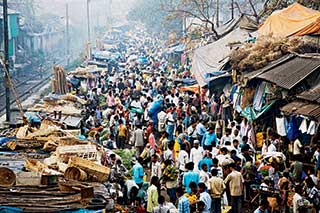 Kolkata’s teeming Malik Ghat wholesale flower market.The paradox embedded in our future is that the fastest way to slow our population growth is to reduce poverty, yet the fastest way to run out of resources is to increase wealth. The trial ahead is to strike the delicate compromise: between fewer people, and more people with fewer needs…all within a new economy geared toward sustainability. Perhaps this is the sixth stage in our demographic maturity: the transition from 20th-century family planning to 21st-century civilizational planning. The shift may seem daunting, but some of it’s already happening. Birth rates continue to fall. And slowly but surely our focus converges as we realize that our common future is entwined with the fate of this small world.
Kolkata’s teeming Malik Ghat wholesale flower market.The paradox embedded in our future is that the fastest way to slow our population growth is to reduce poverty, yet the fastest way to run out of resources is to increase wealth. The trial ahead is to strike the delicate compromise: between fewer people, and more people with fewer needs…all within a new economy geared toward sustainability. Perhaps this is the sixth stage in our demographic maturity: the transition from 20th-century family planning to 21st-century civilizational planning. The shift may seem daunting, but some of it’s already happening. Birth rates continue to fall. And slowly but surely our focus converges as we realize that our common future is entwined with the fate of this small world.
On Tiger Hill at dawn, the people in the crowd—inside and out—are awarded the same prize. A vision appears above the blue mountains of tea and cedar. At 28,000 feet—nearly five miles—above us, the five peaks of Kangchenjunga, the world’s third-highest mountain, broadcast the sunrise minutes before it reaches us. The snows convert from gold to silver to pink with blue shadows. Kangchenjunga means “the five treasures of snows” and is said to house the five treasuries of God: gold, silver, gemstones, grains, and the holy books—as good a metaphor as any for the life-giving vault of earth.
The onlookers cheer. A hundred cameras flash. The alchemy lasts a moment, people melding with mountain and each other, before the fog rolls in and parts us again.
Correction: This figure has been changed to correct an error in conversion.















